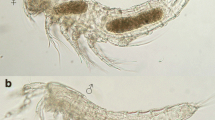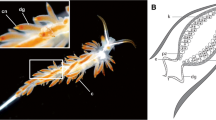Abstract
The structural morphology of the first pereiopod (P1) in crangonoid shrimps is investigated here for the first time using scanning electron microscopy, with particular emphasis on morphological variation in the distal margin (PDM) of the occluding margin of the propodus. Results indicate that there is a high level of morphological variation in the surface ultrastructure of the PDM across the 20 studied genera, assigned to three major types; lamellar, tuberculate and simple. It is postulated that variation in PDM morphology may be explained by its function as a friction-mediated adhesion device that facilitates prey capture, such that the more intricate PDM morphologies may have evolved in response to a selective requirement for a more efficient prey capture device in certain crangonid lineages. Further, comparison with Glyphocrangon indicates that there is no fine-scale structural evidence of homology between the prehensile P1 of Glyphocrangon and the subchelate P1 of Crangonidae.











Similar content being viewed by others
References
Arntz WE, Gorny M (1991) Shrimp (Decapoda, Natantia) occurrence and distribution in the eastern Weddell Sea, Antarctica. Polar Biol 11:169–177
Bauer RT (2004) Remarkable shrimps: adaptations and natural history of the carideans. University of Oklahoma Press, Norman, p 282
Birkely S-R, Gulliksen B (2003) Feeding ecology in five shrimp species (Decapoda, Caridea) from an Arctic fjord (Isfjorden, Svalbard), with emphasis on Sclerocrangon boreas (Phipps, 1974). Crustaceana 76:699–715
Bracken HD, De Grave S, Felder DF (2009) Phylogeny of the infraorder Caridea based on mitochondrial and nuclear genes (Crustacea: Decapoda). In: Martin JW, Crandall KA, Felder DL (eds) Decapod Crustacean phylogenetics. CRC Press, Boca Raton, pp 281–305
Chace FA Jr (1984) The caridean shrimps (Crustacea: Decapoda) of the Albatross Philippine Expedition, 1907–1910, Part 2: families Glyphocrangonidae and Crangonidae. Smithson Contrib Zool 397:1–63
Chace FA Jr (1992) On the classification of the Caridea (Decapoda). Crustaceana 63:70–80
Chan TY, Lei HC, Li CP, Chu KH (2010) Phylogenetic analysis using rDNa reveals polyphyly of Oplophoridae (Decapoda: Caridea). Invertebr Syst 24:172–181
Christoffersen ML (1988) Genealogy and phylogenetic classification of the world Crangonidae (Crustacea, Caridea), with a new species and new records for the South Western Atlantic. Rev Nord Biol 6:43–59
De Grave S, Fransen CHJM (2011) Carideorum catalogus: the recent species of the dendrobranchiate, stenopodidean, procarididean and caridean shrimps (Crustacea:Decapoda). Zoologische Mededelingen 85:195–589
De Grave S, Goulding LYD (2011) Comparative morphology of the pereiopod 1 carpo-propodal (P1-CP) antennal flagellar grooming brush in caridean shrimps (Crustacea, Decapoda). Zool Anz 250:280–301
De Grave S, Wood L (2011) Further occurrences of tegumental scales in caridean shrimp (Crustacea: Decapoda: Caridea). Crustac Res 40:41–50
De Grave S, Pentcheff ND, Ahyong S, Chan T-Y, Crandall KA, Dworschak P, Felder DL, Feldmann RM, Fransen CHJM, Goulding LYD, Lemaitre R, Low ML, Martin JW, Ng PKL, Schweitzer CE, Tan SH, Wetzer R (2009) A classification of living and fossil genera of decapod crustaceans. Raffles Bull Zool Suppl 21:1–109
De Grave S, Li CP, Tsang LM, Chu KH, Chan T-Y (2014) Unweaving hippolytoid systematics (Crustacea, Decapoda, Hippolytidae): resurrection of several families. Zool Scr 43:496–507
Garm A (2004) Revising the definition of the crustacean seta and setal classification systems based on examinations of the mouthpart setae of seven species of decapods. Zool J Linnean Soc 142:233–252
Gorb SN (2008) Biological attachment devices: exploring nature’s diversity for biomimetics. Phil Trans R Soc 366:1557–1574
Gorb SN, Beutel RG, Gorb EV, Jiao Y, Kastner V, Niederegger S, Popov VL, Scherge M, Schwarz U, Vötsch W (2002) Structural design and biomechanics of friction-based releasable attachment devices in insects. Integr Comp Biol 42:1127–1139
Hanamura Y, Matsuoka M (2003) Feeding habits of the Sand Shrimp, Crangon urital Hayashi & Kim, 1999, in the Central Seto Inland Sea, Japan. Crustaceana 76:1017–1024
Heinisch P, Wiese K (1987) Sensitivity to movement and vibration of water in the North sea shrimp Crangon crangon L. J Crust Biol 7:401–413
Henderson PA, Holmes RHA (1987) On the population biology of the common shrimp Crangon crangon (L.) (Crustacea: Caridea) in the Severn Estuary and Bristol Channel. J Mar Biol Ass UK 67:825–847
Holthuis LB (1955) The recent genera of the caridean and stenopodidean shrimps (class Crustacea, order Decapoda, supersection Natantia) with keys for their determination. Zoologische Verhandelingen 26:1–157
Holthuis LB (1993) The recent genera of the caridean and stenopodidean shrimps (Crustacea, Decapoda) with an appendix on the order Amphionidacea. Nationaal Natuurhistorisch Museum, Leiden, p 328
Ingram AL, Parker AR (2005) The functional morphology and attachment mechanism of pandarid adhesion pads (Crustacea: Copepoda: Pandaridae). Zool Anz 244:209–221
Jarrin JRM, Shanks AL (2008) Ecology of a population of Lissocrangon stylirostris (Caridea:Crangonidae), with notes on the occurrence and biology of its parasite, Argeia pugettensis (Isopoda: Bopyridae). J Crust Biol 28:613–621
Jensen GC (2011) Feeding behaviour of the Horned Shrimp, Paracrangon echinata (Caridea: Crangonidae). J Crust Biol 31:246–248
Komai T, Martin JW, Zala K, Tsuchida S, Hashimoto J (2006) A new species of Mirocaris (Crustacea: Decapoda: Caridea: Alvinocarididae) associated with hydrothermal vents on the Central Indian Ridge, Indian Ocean. Scientia Marina 70:109–119
Li CP, De Grave S, Chan T-Y, Lei HC, Chu KH (2011) Molecular systematics of caridean shrimp based on five nuclear genes: implications for superfamily classification. Zool Anz 250:270–279
Martin JW, Liu EM, Striley D (2007) Morphological observations on the gills of dendrobranchiate shrimps. Zool Anz 246:115–125
Mitchell SC, De Mont ME (2003) Analysis of the mero-carpopodite joint of the American lobster and snow crab. I. Apodeme surface area and muscle fibre pinnation angle. J Mar Biol Ass UK 83:1239–1248
Oh CW, Hartnoll RG (1999) Size at sexual maturity, reproductive output, and seasonal reproduction of Philocheras trispinosus (Decapoda) in Port Erin Bay, Isle of Man. J Crust Biol 19:252–259
Oh CW, Hartnoll RG, Nash RD (2001) Feeding ecology of the common shrimp Crangon crangon in Port Erin Bay, Isle of Man, Irish Sea. Mar Ecol Prog Ser 214:211–223
Pihl L, Rosenberg R (1984) Food selection and consumption of the shrimp Crangon crangon in some shallow marine areas in western Sweden. Mar Ecol Prog Ser Oldendorf 15:159–168
Storch V, Bluhm BA, Arntz WE (2001) Microscopic anatomy and ultrastructure of the digestive system of three Antarctic shrimps (Crustacea: Decapoda: Caridea). Polar Biol 24:604–614
van der Veer HW, Bergman MJ (1987) Predation by crustaceans on newly settled 0-group plaice Pleuronectes platessa population in the western Wadden Sea. Mar Ecol Prog Ser 35:203–215
Viegas I, Martinho F, Neto J, Pardal M (2007) Population dynamics, distribution and secondary production of the brown shrimp Crangon crangon (L.) in a southern European estuary. Latitudinal variations. Sci Mar 71:451–460
von Rintelen K, Karge A, Klotz W (2008) News from a small island—first record of freshwater shrimp (Decapoda, Atyidae, Caridina) from Peleng, Banggai Islands, Indonesia. J Nat Hist 42:2243–2256
Wahle RA (1985) The feeding ecology of Crangon franciscorum and Crangon nigricauda in San Francisco Bay, California. J Crustacean Biol 5:311–326
Wicksten MK (2010) Infraorder Caridea Dana, 1852. In: Schram FJ, von Vaupel Klein JC (Eds) Treatise on zoology—anatomy, taxonomy, biology. The Crustacea. Volume 9, part A. Eucarida: Euphausiacea, Amphionidacea, and Decapoda (partim), Leiden: Brill, pp 165–206
Wilcox JR, Jeffries HP (1974) Feeding habits of the sand shrimp Crangon septemspinosa. Biol Bull 146(3):424–434
Zitzler K, Cai Y (2006) Caridina spongicola, new species, a freshwater shrimp (Crustacea: Decapoda: Atyidae) from the ancient Malili lake system of Sulawesi, Indonesia. Raffles B Zool 54:271–276
Acknowledgments
The authors would like to thank Dr. Tomoyuki Komai (Chiba, Japan) for donating some specimens of Japanese crangonids for the study.
Author information
Authors and Affiliations
Corresponding author
Additional information
Communicated by A. Schmidt-Rhaesa.
Rights and permissions
About this article
Cite this article
Wood, L.E., De Grave, S. Functional morphology of the first pereiopod in crangonoid shrimps (Crustacea, Decapoda, Caridea, Crangonoidea). Zoomorphology 134, 469–486 (2015). https://doi.org/10.1007/s00435-015-0270-y
Received:
Revised:
Accepted:
Published:
Issue Date:
DOI: https://doi.org/10.1007/s00435-015-0270-y




